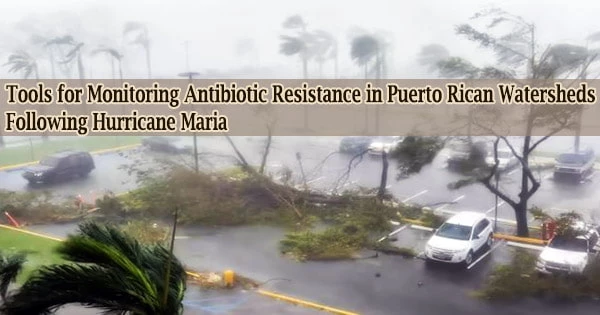Flooding and power outages caused havoc on the battered land when Hurricane Maria made landfall in September 2017, destroying Dominica, St. Croix, and Puerto Rico. This led to the polluting of waterways with untreated human waste and harmful microbes.
Amy Pruden, a professor of civil and environmental engineering at Virginia Tech, organized a group of academics, including Maria Virginia Riquelme and William Rhoads, who were post-doctoral scholars at the time, to travel to Puerto Rico six months after the terrible Category 5 hurricane.
The 3.4 million residents of the American island territory in the northeastern Caribbean Sea were in dire straits due to the devastation. Researchers had a unique chance to examine how the widespread destruction of wastewater infrastructure may have facilitated the spread of antibiotic resistance, a rising worldwide public health problem.
A novel antibiotic resistance surveillance strategy has been further developed by Virginia Tech researchers and international collaborators in a study published in the Journal of Environmental Science & Technology of the American Chemical Society. DNA sequencing techniques were used to detect the spread of disease in watersheds affected by significant storms.
“This study is a critical step toward establishing a unified and comprehensive surveillance approach for antibiotic resistance in watersheds,” said Pruden, the W. Thomas Rice Professor of Civil and Environmental Engineering. “Ideally, it can be applied as a baseline to track disturbances and public health concerns associated with future storms.”
Pruden, a microbiologist, and environmental engineer, has spent the past ten years working with her students to study Legionella strains before, during, after, and outside of outbreaks of the disease in various towns and cities across the nation, including Flint, Michigan, using next-generation DNA sequencing, a field of expertise of Pruden’s.
With RAPID funding from the National Science Foundation and collaborating with principal investigator Christina Bandoragoda, research scientist at the University of Washington with expertise in watershed modeling and geospatial analysis, Virginia Tech researchers teamed up with Graciela Ramirez Toro, professor, and director of the Centro de Educación, Conservación e Interpretación Ambiental, and her research group at the local Interamerican University in San German, Puerto Rico.
This study is a critical step toward establishing a unified and comprehensive surveillance approach for antibiotic resistance in watersheds. Ideally, it can be applied as a baseline to track disturbances and public health concerns associated with future storms.
Professor Amy Pruden
They discovered three sampling locations in watersheds with various levels of wastewater input and land-use patterns that were perfect for identifying geographic trends in the distribution of bacterial genes that produce antibiotic resistance.
In order to find antibiotic resistance genes in river water samples from three watersheds, including samples obtained by hiking to far-upstream, pristine reaches of the watersheds and downstream of three wastewater treatment plants, Benjamin Davis, a doctoral student in Pruden’s program, used a technique called shotgun metagenomic DNA sequencing. The study of genetic material extracted directly from environmental samples is known as metagenomics.
Data analysis showed that, in contrast to genes that particularly corresponded with human fecal markers, two anthropogenic antibiotic resistance markers DNA sequences linked to human influences on the watershed correlated with a different group of antibiotic resistance genes.
A high diversity of genes affecting resistance to clinically significant antibiotics, such as beta lactams and aminoglycosides, were found in the watershed samples, with a distinct demarcation between wastewater treatment plant influence and levels being elevated downstream of wastewater treatment plants.
Some of the beta lactam resistance genes found in the area were linked to fatal antibiotic-resistant diseases and displayed evidence of being able to hop between bacterial strains. Furthermore, anthropogenic antibiotic resistance markers were found to be more reliable predictors of beta lactam resistance genes than human fecal markers.
Although the levels of antibiotic resistance genes in Puerto Rican watersheds before Hurricane Maria remain unknown, the researchers noted that surveillance techniques like these might be used to predict how future significant storms will affect the spread of antibiotic resistance.
The identification of single gene targets, such as the anthropogenic antibiotic resistance markers, makes watershed surveillance of antibiotic resistance much more accessible. However, many international communities won’t likely have access to sophisticated metagenomic-based monitoring tools in the near future.
Additionally, such genes can be directly quantified using a quantitative polymerase chain reaction, which provides quick, affordable results in less than a day.





